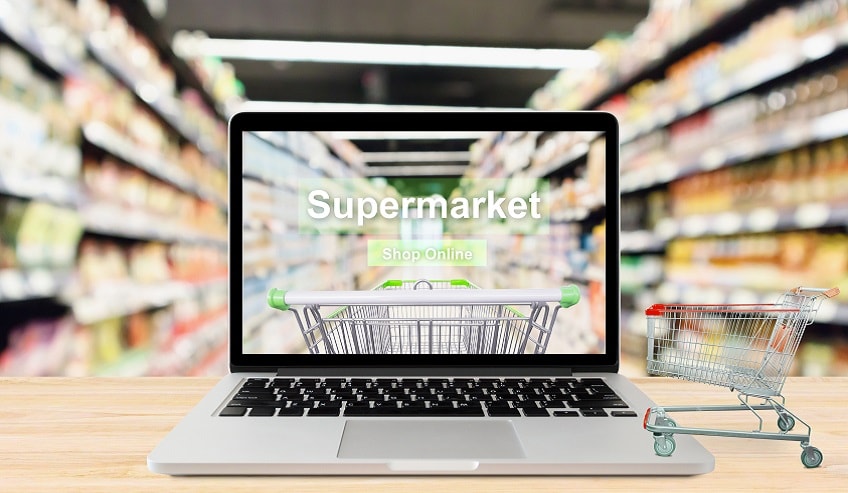
The Glue Talk Blog

Consumers haven’t adapted to online grocery shopping as quickly as they’ve adapted to e-commerce in other categories such as electronics, books and apparel.
While the e-commerce market for food and grocery is still a small part (2 to 6 percent) of the $1 trillion U.S. food industry, it has grown over 30 percent in 2019, and overall global sales will rise 24 percent year-over-year through 2023. Online grocery penetration has increased rapidly in the U.S. in recent months, reaching 30 percent of the total population. Annual spending on food and alcohol through e-commerce is this year predicted to reach $20 billion. (Source)
Shoppers are generally less willing to pay more for essentials like groceries, and also tend to prefer picking their own fresh items. Consumers also worry that items could spoil, spill or get damaged in transit.
While shoppers are slowly becoming more comfortable with shopping online for routine groceries, more than half of U.S. digital food shoppers who had purchased food and beverages online in 2019 said they bought packaged snack foods like chips, cookies and candy in the past month. And, more than one-third purchased dry/baking goods like cereal, flour and pasta. Products like fresh fruit and vegetables, bread and baked goods, eggs and dairy, meat, poultry and seafood were purchased by fewer than one-quarter of digital food buyers. (Source)
Consumer studies of online shopping behavior finds that convenience is key for online grocery shopping. Subscriptions and memberships are key drivers of brand loyalty and will continue to be a major factor in the growth of ecommerce moving forward. Most major food retailers are beginning or expanding delivery, or adding pickup locations of online orders. For example, Walmart, Target and Amazon all now offer same-day delivery in most major markets. Kroger Co. has developed a partnership with British online grocer Ocado Group. The two plan to build as many as 20 automated grocery warehouses in the U.S. to help Kroger turbocharge its e-commerce operation. (Source)
Product packaging is in a unique position to help e-grocers tackle consumer concerns with online grocery shopping. Unique packaging innovation can make online grocery shopping more attractive for both retailers and consumers. By reducing packaging weight, right-sizing packages so they take up less space, and protecting products from damage, converters can help shoppers overcome their reluctance to purchase groceries online. E-grocery products with opportunities for growth include lightweight products, fully recyclable packaging, labels that better communicate product quality information, meal kits and products that prioritize convenience.
- Ensuring Quality and Safety
To ensure product quality and safety, flexible packaging is aided by films that can act as a protective oxygen barrier or moisture barrier system to keep toxic elements from the contents, as well as add an extra layer of safety when dealing with sharp products that could puncture or damage contents during the shipping and handling process. Innovative packaging solutions that can help preserve freshness, quality and taste will help convert wary consumers to e-grocery loyalists.
- Improving Transportation
Transporting products in a safe and cost-efficient way is essential for both flexible packaging converters and brand owners that want to succeed in grocery e-commerce.
- Active Packaging Solutions
Gas scavengers – widely used in meal kits – react with gases to prevent degradative reactions. They exist in sachets, film and enzymes, and can be used in a variety of ways. Other active packaging solutions include antimicrobials, biosensors and smart labels.
- Increasing Sustainability
New film technology is helping to move product goods from rigid materials (like glass) to flexible packaging options that use recyclable polyethylene or biodegradable polylactic acid to increase sustainability and green initiatives.
Forrester research has predicted that online retail sales in the United States will reach $500 billion by 2020. In order to stay ahead in the e-grocery market, converters need to work with brand owners to optimize the product packaging process and deliver strong product protection or they run the risk of transporting and/or delivering damaged items. (Source)
H.B. Fuller understands the flexible packaging e-commerce market. Our adhesives work on a variety of substrates, and our technical experts know how to optimize your converting equipment to avoid down time and waste.
Blog Categories
Blog Categories
Archive
- 2024
- 2023
- 2022
-
2021
- January (3)
-
February (7)
- Celebrating Exceptional Service During COVID-19 Complications
- Cyanoacrylates: What They Are and What They Do
- Innovative two-shot bookbinding adhesive
- Make a Difference 2020
- Problem Solving: Paper Straws in Drinking Beverages
- Stronger straws sustainable future
- Substances of Interest in Disposable Absorbent Hygiene Products
- March (4)
- April (4)
- May (4)
- June (5)
- July (2)
- August (5)
- September (2)
- October (1)
- November (3)
- December (2)
-
2020
- January (4)
- February (2)
- March (3)
- April (4)
- May (3)
-
June (7)
- Community Support in the Era of Coronavirus
- HBFuller Employee Creates Face Shields with 3D Printer
- Improved Packaging Integrity and Greater Customer Satisfaction
- Liquid-Resistant Paper Straws
- What is a Sealant?
- What Is the Future of Commercial Disinfectants?
- Winning over consumers with e-commerce packaging solutions
-
July (6)
- Employees Take Action to be Part of Healing and Growth
- Gain a competitive advantage with packaging adhesive solutions
- HB Fuller Company Foundations Commitment to Communities
- Packaging Solutions for the South African Agriculture Market
- Supporting Organizations That Provide STEM Education for Youth
- Where Does Sustainability Stand Amid COVID-19
- August (3)
- September (2)
- October (4)
- November (2)
- December (4)
